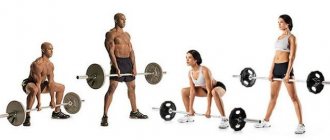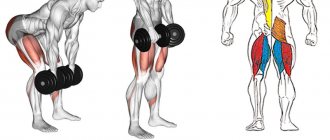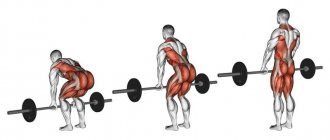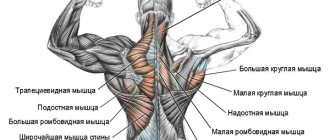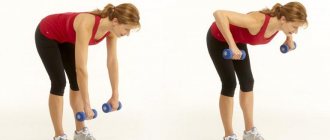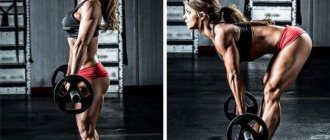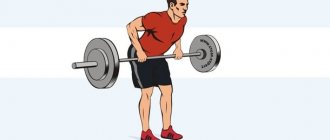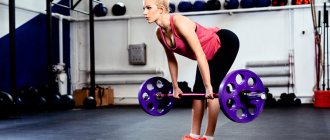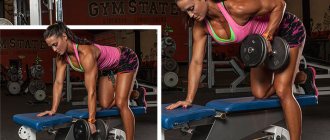Having a beautiful and sculpted body is the dream of many who go to the gym. Each sporting direction has its own basic elements. So, when working with free weights in the gym, you can distinguish 3 basic general developmental exercises - the bench press, deadlift and squat with a barbell. In this article we will talk about deadlifts and look at all the features of the exercise.
This article is sponsored by the online flower store kaktuc; on this resource you can order delivery of flowers in hat boxes in Moscow simply by following the link!
What problems does deadlift solve?
If we consider deadlift as part of extreme strength and powerlifting, then it is considered a competitive discipline. It is performed with maximum effort - with a weight with which the athlete can perform one full repetition. The correctness of each stage of execution and the overall assessment of the technique are taken into account.
Reference. Powerlifting requires only a standard barbell deadlift or its variation - “sumo”, which allows you to evenly distribute the load.
In bodybuilding, and simply for people exercising for their own pleasure, the exercise involves an average weight for several repetitions. The goal is to generally work out the muscles and increase their volume.
The deadlift is a multi-joint exercise. It allows you to use ¾ of your muscles, so it is great for improving muscle protein synthesis.
Incorporating deadlifts into a mixed martial arts fighter's training program can improve endurance and pulling strength. It works the muscles that are necessary to carry out throws and lift the opponent off the ground, to take him to the ground.
A set of warm-up exercises for squats
Difficult coordination movements require special warm-up. Before starting the approach with the bar, and after performing the general warm-up described above, you need to:
- Perform 1-2 sets of lunges from side to side. The feet are wider than the shoulders, the knees are bent, the pelvis is laid back, you should bend the knee, move it to the side, and transfer weight from one leg to the other;
- Then - the gluteal bridge approach without weights, with the shoulder blades resting on the bench. The shins are perpendicular to the floor, the buttocks drop low, the exit to the bridge is at a comfortable amplitude;
- The special warm-up ends with ankle stretching. You should lean your hands on the wall and take a lunge position. The stretched leg is behind, its heel tends to the floor.
For a hip-dominant style of squatting, when the buttocks are strongly retracted, it is recommended to tie the hips with a rubber shock absorber and perform several warm-up approaches without weight. For knee dominant, one set of goblet squat.
All this needs to be done if you plan to reach a weight approximately equal to the athlete’s own weight or higher; if the weight is less, then you can get by with warming up with a bar.
What muscles work
The exercise is usually classified as a traction exercise. In terms of the volume of muscles simultaneously involved in work, deadlift occupies a leading position.
When performing deadlifts, the following muscles work :
- "back extensor";
- buttocks, as well as the quadriceps, biceps and adductor muscles of the thigh;
- lats, trapezius, rear deltoids;
- brachyradialis, forearm and biceps.
Varieties of deadlift
There are several types of deadlift They allow you to specifically use slightly different muscles. In addition, the presence of varieties allows you to take a comprehensive approach to working out a specific muscle group. If you are a beginner, we suggest you master the basic technique of deadlifting with an empty bar .
Classical
The classic version is the most common. Let's look at the step-by-step implementation of this exercise.
- The grip of the barbell is wider than shoulder width . The legs are placed a little narrower. Feet opposite each other. The back is straight throughout the entire execution.
- The bar should be close to your shins, so wear gaiters to avoid skin damage.
- While standing, initially move your shoulders and shoulder blades back.
- Primary traction is achieved through the work of the legs and buttocks. With their force, tear the barbell off the floor and, having reached the amplitude of 25%, engage the back muscles, making a full extension.
- In reverse order, lower the barbell down to the floor.
This option uses the back muscles to a greater extent. Therefore, it is recommended for athletes who do not have very well developed legs. It is also the most optimal for people who are just starting to train in the gym.
Lifter sumo
sumo deadlift At the same time, the torso muscles receive predominantly static load. This is due to the specificity of the exercise, which significantly reduces the extension work in the lower back.
The exercise can be divided into the following stages.
- Take the barbell by the bar, slightly narrower than your shoulders. The legs are placed wide, the feet are slightly turned to the side.
- Keeping your back straight and not leaning forward, make the ascent using mainly the work of your leg muscles.
- Next, lower the barbell to the floor and repeat the exercise.
This variety requires sufficient stretching from the athlete. When overloaded, the adductor muscles of the hips can be damaged - from stretching to tearing. We also strongly recommend that you do not perform this exercise “cold”. A good place to start would be to jump rope, run and do burpees. If the stretch is not very good, you can not place your legs so wide, and then gradually come to a full performance.
Rounding the back and putting it into work leads to injury and minimizes the usefulness of the exercise. Bend forward in the lower position and force the back together with the legs make it easier to lift, but disrupt the technique. During sumo deadlifts, the back takes only 20% of the load in the final stage (straightening to a standing position). If you experience discomfort and still put the load on your lower back, then it’s better to do the classic version.
Romanian (or "dead") deadlift
This deadlift received its name due to the use of straight legs when lifting the barbell. For full performance, good stretching of the legs and, in particular, the hamstrings is necessary. The exercise works the buttocks and thighs in isolation.
The traction movement is carried out by abducting the buttocks. What plays here is not the weight used, but the neuromuscular connection developed. You should feel which muscles are working. Additionally, using too much weight can cause damage to your hamstrings, requiring several weeks of recovery.
Dumbbells are suitable for this variation . They allow you to better load the muscles by increasing the amplitude, which will depend on your stretching.
With trap bar
Having a trap bar in the gym makes deadlifting safer and more effective. This projectile is a diamond-shaped design with parallel handles. In addition, they are at waist level, which allows you to better control keeping your back straight.
The technique is as follows.
- Step into the bar and grab the handles.
- Lean forward with your pelvis abducted and your knees . Arms straight.
- Lift the barbell using your leg muscles.
- As you rise, increase the arch, keeping your back straight.
- Pause at the top and return under control to the starting position.
What is a deadlift? Theoretical basis. Types of deadlifts
The deadlift is one of the basic exercises that is performed with a barbell, sometimes a kettlebell or a dumbbell.
The deadlift, along with the bench press and squats, is one of the classic powerlifting disciplines. Proper execution allows the trainee to achieve good results in a few months and perfectly develops muscles. This challenging exercise works most of the muscles in your body, especially strengthening your lower back.
Classic deadlifts are performed with narrow legs that barely touch the bar itself. During the exercise, most of the load falls on the back; the legs work only at the beginning, when lifting the apparatus. Typically, this type of deadlift is recommended for athletes with weak legs, small arms (in length) and short fingers.
This physique and anatomical features significantly affect technique, preventing the athlete from holding large weights for a long time. For best results, use a lock grip, with the knuckle of the thumb supporting the rest.
Classic deadlift
“Dead lift”, or “dead lift”, is performed on straight legs.
This deadlift cannot be used in powerlifting competitions due to the excessive amount of damage the athletes receive. When an athlete leans towards the apparatus and lifts it, he practically does not bend his legs, which puts a lot of stress on his knees.
Deadlift
The sumo deadlift is a straight-legged deadlift. When doing this, you need to spread your legs wide apart so that your toes barely touch the plates, and always keep your back straight.
Sumo deadlift
The Romanian deadlift is a very popular exercise in both men's and women's circles, because... it works very hard on the back of the thigh – the biceps. Place the barbell on the supports at mid-thigh height. Grasp the barbell with an overhand grip at a distance slightly wider than shoulder width. Keep your knees slightly bent.
Romanian deadlift
The trap bar deadlift differs little from the classic technique. The main differences are that the legs are placed wide, literally touching the plates, and the hands hold the bar with a narrow grip. This simplifies the last phase of the exercise (lowering the implement) and allows the lifter to lift more weight.
Trap bar row
Deadlift technique
The correct technique allows you to work all the necessary muscles and prevent possible injuries. The lower back is always at greatest risk, since the rounding of the back transfers most of the load to it.
Proper weight lifting
Lifting the barbell begins with a vertical shrug of the trapezius muscle. Having grabbed the barbell, move your shoulders back, feel the rigid fixation in your back.
The gaze is directed forward. The first stage of traction is carried out due to the work of the leg muscles. Imagine the movement as a leg press, but in a different projection. The bar literally “slides” along your legs. After bringing the barbell to your kneecaps, begin to exhale and perform further extension, including your back in the work. It should remain level throughout the entire ascent.
Proper lowering of weight
Lowering the barbell loads the muscles no less than lifting it. Proper technique is also important here. The weight should descend strictly vertically. Primary movement occurs due to the work of the hip joint. Avoid arching your lower back.
The main part of the load is taken by the legs, since they are the ones who control the lowering of the bar. The body and back only support the vertical position of the bar.
As you approach your knees, keep the bar next to your legs, also “sliding” along them. By increasing the distance between the barbell and your legs, you increase the load on the lower back and also force the body to lean forward, which leads to poor technique and rounding of the back. When the projectile touches the floor, without relaxing your grip and muscles, begin lifting again.
Breath
One repetition of a deadlift requires 2 inhalations and two exhalations. Fill your lungs with air by grasping the bar, bringing it to your knee joints, and begin to exhale. The exhalation phase ends at the top point. When you finish lifting, inhale again as you begin to bend your knees, and then continue lowering. As you lower the bar, exhale. Then the cycle repeats.
"Dead" or Romanian deadlift
It is not used in powerlifting due to increased trauma and the inability to lift maximum weight. It differs from the classic deadlift in that the legs are straightened completely or almost completely throughout the exercise (determined by individual anatomical features). Width – shoulder level or narrower.
The technique of performing a “dead” deadlift is completely similar to the classic version. The specificity of the exercise is that the load is accentuated on the back and buttocks, the legs are involved to a lesser extent than in the classic version.
“Dead” deadlifts are practiced mainly by bodybuilders, in particular – Arnold Schwarzenegger used only “dead” (Romanian) deadlifts9, not classical ones, in his training.
Features of the deadlift:
- – The work is performed with light weight (individually up to 50-70% of the maximum).
- – The exercise is performed with a large number of approaches (from 3 workers) and repetitions (from 10).
- – It is permissible to lower the bar not all the way to the floor, but to the middle of the shin.
This variation is called a deadlift because ideally the legs should be completely straight and motionless. However, due to the lack of flexibility in the legs, athletes often allow a slight bend in the knees.
Errors during execution
When performing deadlifts , especially inexperienced people often make mistakes. Let's look at the most common of them.
- Rounded back. Some people subconsciously round their upper back, which reduces the trajectory of the barbell. However, this also increases the load on the lower back.
- Excessive extension at the top. The body should be straight at the top, do not bend back.
- Using the squat technique. Many people, due to lack of stretching, practically go into a full squat in the starting position. This is fundamentally incorrect; the bend in the knees is about a third of the maximum.
- Sudden movements and jerks. Exercises increase injury rates.
- Barbell toss. Sometimes athletes lower too quickly, hitting the barbell on the floor and, taking part of the inertia from the impact, lift it up again. It looks epic, but the risk of injury increases, and the muscles do not receive the proper load.
Do you need insurance and seat belts?
Deadlift Safety Straps
If you are training purely for yourself and do not plan to compete, then you are unlikely to need insurance. Belts are typically used by athletes in tournaments to allow them to lift heavier weights. But for ordinary trainees, it is important to first perform the exercise without mistakes, so as not to get injured.
Deadlift harness
Unlike squats, deadlifts do not require two people to perform. In case of incorrect technique, severe pain or other force majeure situation, you can always throw the barbell, for which you do not need a spotter.
Additional Deadlift Tips
It is mandatory to perform it in full amplitude (full extension at the top and touching the floor with the barbell). Violations of the technique may make it easier to perform, but lead to an increased risk of injury.
Before training, pay attention to warming up your back and knee joints. It is these places that are subject to the most stress.
Feel free to use a weightlifting belt. If you are a beginner, then its use will be appropriate for small scales.
Training regimen: how often should you exercise?
The deadlift is an energy-intensive and multi-joint exercise. If your goals are not records in powerlifting (professional athletes do exercises up to 3 times a week), but muscle growth and development, then the most acceptable option would be once a week or two weeks. Standard deadlifts are best performed while working your back. The “deadlift” or “sumo” variety is better suited for the legs.
If you begin to experience discomfort in your back, stop doing the exercise. If the pain does not go away after a few days, consult a doctor.
Crossfit complexes
For convenience, we will provide you with several CrossFit complexes that can be used for training.
Complex 1.
- Rowing on a machine.
- Deadlift.
- Jumping on a box.
Complex 2.
- Leg lifts to the bar.
- Deadlift.
- Standing push-ups.
- Deadlift.
Perform each exercise to the maximum. The total duration of the set is 12 minutes.
Complex 3.
- Burpee with jumping over the bar.
- Deadlift.
- Pull-ups.
Complex 4.
- Burpee.
- Leg lifts to the bar.
- Deadlift.
- Throwing a ball against a wall.
- Deadlift.
- Push-ups with clap.
- Deadlift.
The goal is the minimum time for 1 lap while observing the technique.
You adjust the weight, number of repetitions and execution time to suit you. It should be hard, but realistic to achieve your goals.
Adviсe
In theory, the choice of “classic or sumo” depends on anatomical features. Long arms and a weak back - “sumo”. A strong back and weak legs plus poor hip mobility (“tight hips”) is a classic. In practice, in powerlifting, the width of the feet is selected empirically. Options are possible with “half sumo”, when the toes are turned out, and the heels are placed only slightly wider than the shoulders, “different grip”, when the palms are turned “towards” each other.
In practice, deadlifts should be avoided by people with poor posture and hernias or protrusions. There is a radical point of view - you can pull, but by strengthening your back muscles. In any case, the technique must be taught by a trainer who is proficient in kinesiotherapy and rehabilitation.
Alternative Deadlift Exercises
The deadlift is a unique exercise that works almost all skeletal muscles. Contraindications to its implementation are the presence of injuries, lack of stretching or muscle imbalance.
Alternative exercises can be considered those that allow you to specifically work out certain muscle groups.
This may include:
- pull-ups;
- hyperextension;
- shrugs with a barbell;
- leg flexion/extension on a machine;
- leg press;
- bent over barbell row.
About equipment
The most important piece of equipment is the weightlifting belt. Allows you to fix your lower back, helping to avoid sagging and injuries.
Straps are an auxiliary attribute that is used for heavy weights. Allows you to improve your grip by preventing the bar from slipping.
Magnesia is another element for working with heavy weights. Provides a strong grip and prevents palms from sweating.
